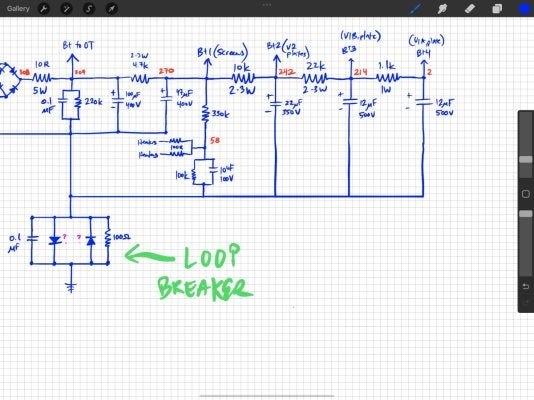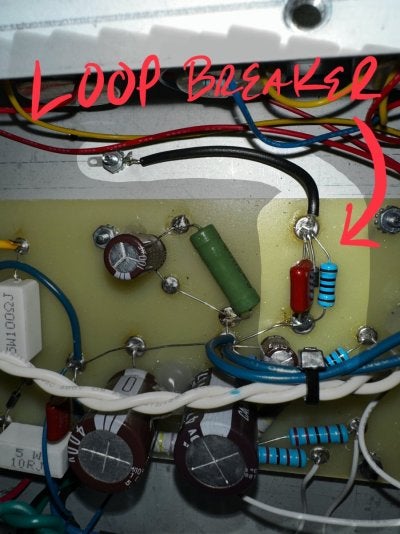kleydejong
Tele-Holic
Introduction
Hello friends, I'd like to start a new project. I haven't built an amp from scratch since 2022 - so about 3 years... Sad days. Part of the problem is I've been so happy with the fleet of amps I have, I just don't really have space or need for more. I haven't really wanted to get into building amps to sell for various reasons. So I just haven't...
All that is about to change though! I have been mulling on this project for about 7 years now. I started a thread here:
https://www.tdpri.com/threads/tube-driven-overdrive-preamp-pedal.795272/
That was back in 2018! I got a lot of great feedback. My initial intention is to adapt inspiration from the Kingsley line of high voltage tube driven pedals. But I got a bit intimidated by a few elements of that build. Mostly making a DC power supply that would play nicely with a typical guitar pedalboard power supply. There is a lot of great information in that thread worth reading.
But I'm going to press forward with this build. I'm considering this a prototype. I'm going to intentionally keep things simple and basic. I most likely will iterate on this more in the future.
Design Goals
I want to make a high voltage tube driven overdrive pedal. I want to run it on a pedalboard. I want to run it into the front end of a tube amplifier. I want it to be low to medium gain. I want it to be simple and toneful.
For the power supply I'm going to stay in a safe place and use a 120 vac IEC type power supply input. I'll run it into a fuse - switch. Then into a small Hammond power transformer mounted INSIDE the enclosure. We'll rectify the B+ with diodes. Then smooth it with some filter caps and a step down resistor. Then run two simple 12AX7 gain stages for the audio signal. Gain and Level controls. Maybe some very simple tone filtering. No tone stacks or any shenanigans like that.
Circuit
I have been drawing a schematic in Eagle to mess around with and this is where I'm at currently.

And a layout:

The power supply is incomplete because I don't really know how to do those components in Eagle. I usually just copy a layout from an old Fender that I know well anyways.
Pretty straightforward. I'm thinking a switched cathode bypass cap on V1A will tighten bass going from 10 uf (full frequency) to .68uf (tighter). Then I would like to try Rob's Sizzle control which basically takes a bright cap around the gain pot. Introduce a pot to add resistance to reduce the bright cap. Then once you go past half way on the pot you introduce a dulling circuit. Hoping this setup has less insertion loss, yet provides some tone shaping.
I see a lot of people making more of a 'preamp' where you basically copy a well known preamp design. That doesn't really make sense to me as an overdrive pedal. I want an EQ section that compliments being run into an amp with a tone stack, not duplicates it.
One other element to mention is that I believe Kingsley's drive pedals would add a solid state boost circuit to the input to drive V1A. My circuit would only use V1A to boost the signal into V1B to introduce distortion. So I may later consider adding a very small one knob boost circuit to the input.
Parts
I thought a lot about enclosure and I think the Hammond 1590E will work. It is rather large at about 7" x 4" x 3".
https://www.amplifiedparts.com/products/chassis-box-hammond-1590e-diecast-740-x-472-x-307
I think the height and length will be nice as I want to enclose the transformer and the 12AX7 internally. I also want to build on a turret board so I can access the components reasonably well. I've done some very tight PTP work and in the long run it is hard to work on.
Next Hammond has the 261E6 and Hammond 262E6 transformers which look good for this project. The 261E6 has a 250 vac secondary while the 262E6 has a 120 vac secondary. I actually have one of each, so we'll see. My first reaction is that the 120 vac secondary would be too low, but on second glance it might be pretty cool.
My research says you can estimate your voltage by taking the AC RMS voltage times 1.41 to give you max DC voltage. So 120 * 1.41 = 169 vdc. I think that could work. Might try to draw the load lines and see what I see.
Here is my first layout:

Time to drill some holes in the chassis!
Hello friends, I'd like to start a new project. I haven't built an amp from scratch since 2022 - so about 3 years... Sad days. Part of the problem is I've been so happy with the fleet of amps I have, I just don't really have space or need for more. I haven't really wanted to get into building amps to sell for various reasons. So I just haven't...
All that is about to change though! I have been mulling on this project for about 7 years now. I started a thread here:
https://www.tdpri.com/threads/tube-driven-overdrive-preamp-pedal.795272/
That was back in 2018! I got a lot of great feedback. My initial intention is to adapt inspiration from the Kingsley line of high voltage tube driven pedals. But I got a bit intimidated by a few elements of that build. Mostly making a DC power supply that would play nicely with a typical guitar pedalboard power supply. There is a lot of great information in that thread worth reading.
But I'm going to press forward with this build. I'm considering this a prototype. I'm going to intentionally keep things simple and basic. I most likely will iterate on this more in the future.
Design Goals
I want to make a high voltage tube driven overdrive pedal. I want to run it on a pedalboard. I want to run it into the front end of a tube amplifier. I want it to be low to medium gain. I want it to be simple and toneful.
For the power supply I'm going to stay in a safe place and use a 120 vac IEC type power supply input. I'll run it into a fuse - switch. Then into a small Hammond power transformer mounted INSIDE the enclosure. We'll rectify the B+ with diodes. Then smooth it with some filter caps and a step down resistor. Then run two simple 12AX7 gain stages for the audio signal. Gain and Level controls. Maybe some very simple tone filtering. No tone stacks or any shenanigans like that.
Circuit
I have been drawing a schematic in Eagle to mess around with and this is where I'm at currently.

And a layout:

The power supply is incomplete because I don't really know how to do those components in Eagle. I usually just copy a layout from an old Fender that I know well anyways.
Pretty straightforward. I'm thinking a switched cathode bypass cap on V1A will tighten bass going from 10 uf (full frequency) to .68uf (tighter). Then I would like to try Rob's Sizzle control which basically takes a bright cap around the gain pot. Introduce a pot to add resistance to reduce the bright cap. Then once you go past half way on the pot you introduce a dulling circuit. Hoping this setup has less insertion loss, yet provides some tone shaping.
I see a lot of people making more of a 'preamp' where you basically copy a well known preamp design. That doesn't really make sense to me as an overdrive pedal. I want an EQ section that compliments being run into an amp with a tone stack, not duplicates it.
One other element to mention is that I believe Kingsley's drive pedals would add a solid state boost circuit to the input to drive V1A. My circuit would only use V1A to boost the signal into V1B to introduce distortion. So I may later consider adding a very small one knob boost circuit to the input.
Parts
I thought a lot about enclosure and I think the Hammond 1590E will work. It is rather large at about 7" x 4" x 3".
https://www.amplifiedparts.com/products/chassis-box-hammond-1590e-diecast-740-x-472-x-307
I think the height and length will be nice as I want to enclose the transformer and the 12AX7 internally. I also want to build on a turret board so I can access the components reasonably well. I've done some very tight PTP work and in the long run it is hard to work on.
Next Hammond has the 261E6 and Hammond 262E6 transformers which look good for this project. The 261E6 has a 250 vac secondary while the 262E6 has a 120 vac secondary. I actually have one of each, so we'll see. My first reaction is that the 120 vac secondary would be too low, but on second glance it might be pretty cool.
My research says you can estimate your voltage by taking the AC RMS voltage times 1.41 to give you max DC voltage. So 120 * 1.41 = 169 vdc. I think that could work. Might try to draw the load lines and see what I see.
Here is my first layout:

Time to drill some holes in the chassis!












